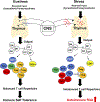Defining Early Life Stress as a Precursor for Autoimmune Disease
- PMID: 32422015
- PMCID: PMC11102636
- DOI: 10.1615/CritRevImmunol.2020033244
Defining Early Life Stress as a Precursor for Autoimmune Disease
Abstract
Childhood exposure to traumatic events, termed early life stress (ELS), is now widely recognized for causing long-term negative health effects that may not manifest until adulthood. Allostatic load (AL) describes the cumulative "wear-and-tear" effects of chronic stress on the body that may adversely affect human health by accelerating other disease processes. Recent epidemiological studies have reported higher stress levels in industrialized countries and trends of increasing prevalence in autoimmune diseases during recent decades. To elucidate mechanisms of stress-related immune dysregulation, most animal studies up to now have focused on AL and stress-triggered events occurring in adults but have not explored ELS in the context of autoimmune disorders. We have identified a current gap in understanding the impact of ELS on immune system ontogeny and its potential for priming genetically susceptible individuals who are at increased risk for autoimmune diseases later in life, through mechanisms involving neuroendocrine-immune cross talk. In this review, we highlight the intersection between stress and immune function, with a focus on ELS as consequential for increased autoimmune disorder risks later in life.
Figures


Similar articles
-
The Link between Psychological Stress and Autoimmune Response in Children.Crit Rev Immunol. 2015;35(2):117-34. doi: 10.1615/critrevimmunol.2015013255. Crit Rev Immunol. 2015. PMID: 26351146 Review.
-
[Neurobiology of early life traumatic stress and trauma: Prolonged neuroendocrine dysregulation as a neurodevelopmental risk factor].Psychiatriki. 2023 Jul 19;34(2):122-132. doi: 10.22365/jpsych.2022.059. Epub 2022 Feb 21. Psychiatriki. 2023. PMID: 35255464 Review. Greek, Modern.
-
Neuroimmunoendocrine interactions in post-traumatic stress disorder: focus on long-term implications of childhood maltreatment.Neuroimmunomodulation. 2014;21(2-3):145-51. doi: 10.1159/000356552. Epub 2014 Feb 14. Neuroimmunomodulation. 2014. PMID: 24557048 Review.
-
Early Life Stress as a Predictor of Co-Occurring Alcohol Use Disorder and Post-Traumatic Stress Disorder.Alcohol Res. 2018;39(2):147-159. Alcohol Res. 2018. PMID: 31198654 Free PMC article. Review.
-
Psychological Stress, Intestinal Barrier Dysfunctions, and Autoimmune Disorders: An Overview.Front Immunol. 2020 Aug 25;11:1823. doi: 10.3389/fimmu.2020.01823. eCollection 2020. Front Immunol. 2020. PMID: 32983091 Free PMC article. Review.
Cited by
-
Stress hormones mediate developmental plasticity in vertebrates with complex life cycles.Neurobiol Stress. 2021 Feb 2;14:100301. doi: 10.1016/j.ynstr.2021.100301. eCollection 2021 May. Neurobiol Stress. 2021. PMID: 33614863 Free PMC article.
-
Adverse childhood experiences in patients with psoriasis.Trends Psychiatry Psychother. 2022 Aug 31;44:e20210251. doi: 10.47626/2237-6089-2021-0251. Trends Psychiatry Psychother. 2022. PMID: 33984200 Free PMC article.
References
-
- aarda.org [homepage on the Internet]. Autoimmune disease list. Eastpoint, MI: American Autoimmune Related Diseases Association, Inc. [updated 2017 May 10; cited 2019 Oct 1]. Available from: https://www.aarda.org/diseaselist/.
-
- niaid.nih.gov [homepage on the Internet]. Autoimmune diseases. National Institute of Allergy and Infectious Diseases. Bethesda, MD: National Institutes of Health; [updated 2017 May 2; cited 2019 Nov 20]. Available from: https://www.niaid.nih.gov/diseases-conditions/autoimmune-diseases.
-
- Nagata S, Suda T. Fas and Fas ligand: lpr and gld mutations. Immunol Today. 1995;16(1):39–43. - PubMed
Publication types
MeSH terms
Grants and funding
LinkOut - more resources
Full Text Sources
Medical
Miscellaneous

